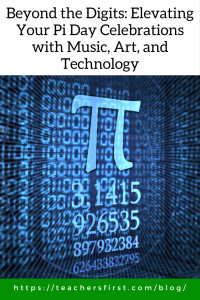What did Pi say when asked if they could explain
what Pi Day was again?“I don’t want to repeat myself.”
On March 14, 1988, physicist and San Francisco Science Museum employee Larry Shaw revolutionized how we celebrate mathematics by organizing the first-ever Pi Day. This date, representing the first three digits of Pi, also happens to coincide with the birthday of the legendary Albert Einstein, who was born on March 14, 1879.
Pi Day is now a global school celebration marked by diverse activities like pie-eating contests, recitation challenges, and Pi-themed crafts. Incorporating technology and cross-curricular learning activities offers opportunities to add an extra layer of engagement and fun to your Pi Day celebrations to capture the attention of even the most math-phobic students.
Unleash the Power of Pi through Music:
- Introduce Pi Day with music videos set to popular songs, then ask students to write or perform a Pi Day song. This example, set to “867-5309/Jenny,” is an excellent choice to share with students as inspiration for how to create a Pi Day music video. Another student-created example features seventh graders showing their creativity with their adaptation of Pharrell William’s “Happy.” Here are two other ways to complete this activity:
- Use the instrumental version of “867-5309/Jenny” and the lyrics from the parody video to have students create and film a video about Pi. You can find many other instrumental versions of popular songs on YouTube.
- Find the Song Generator tool on MagicSchool.ai (reviewed here) to write a custom song to the tune of your choice, then have groups of students perform their Pi songs. The Song Generator tool works best when asked to use popular songs that have a catchy chorus, such as “Walking on Sunshine” or “We Are the Champions.”
- Share music videos designed to teach the concept of Pi with catchy lyrics, such as “Pi Day – the song” and “Pi for Kids.” You can also:
- Use EdPuzzle (reviewed here) or Twee (reviewed here) to generate a set of questions for students to answer about the content of these videos.
- Share teaching videos on a Symbaloo Learning Path (reviewed here) as part of a flipped learning activity. Add videos, websites, interactives, quizzes, and more to your learning path to provide options for student choice and differentiation of activities.
- Create a symphony with friends using Pi to structure the composition. Assign everyone a number from 1 through 9 and have each person create a musical sound associated with their number. Use sounds like claps, hums, snaps, whistles, knocks, and beats on a drum or tambourine or other available musical instruments, and use zero as a rest.
Express Pi through Art:
- Create a Pi Skyline with the directions on Math Art for Kids: Pi Skyline (reviewed here). You can also try these adaptations:
- Instead of coloring in the graph with markers as demonstrated in the article, use graph paper and colored squares of construction paper to create a skyline graph mosaic.
- If a 3D printer is available, challenge students to design a Pi skyline using the printer.
- Create circular or spiral Pi art projects such as the one shown in this image from Pixabay (reviewed here). Challenge students to include as many digits of Pi as they can!
Embrace Pi with Technology:
- Conduct a digital conversation about Pi Day with this online chatbot on SchoolAI (reviewed here). Use this conversation to learn about Pi and its many uses and to clarify misconceptions about the understanding of Pi.
- Find your Pi birthday (or any other day) at MyPiDay. This site uses the Wolfram Language to calculate Pi to millions of digits quickly, then uses this information to locate dates within the string of digits. Ask students to use MyPiDay to find the location of their birthdate, then compare results and place them in numerical order. Do students see any patterns or reasoning behind the results?
- Try this Pi Day digital breakout in groups, or create a digital escape room using Google or Microsoft tools. Learn how to make a digital escape room by watching OK2Ask: Engage & Inspire: Digital Escapes with Google and OK2Ask: Engage & Inspire: Digital Escapes with Microsoft on demand.
- How about some Pi Day trivia? Use this existing quiz from Quizziz (reviewed here) to test your students’ knowledge of Pi either as a live quiz or as an asynchronous practice activity. If desired, copy and edit the quiz to suit your needs.
Pi Day is not just about numbers; it’s a chance to infuse fun into learning math. Find many other Pi Day learning activities and suggestions in this Wakelet collection, or add your favorite activities! Share your Pi Day suggestions in the comments below, and let’s make this Pi Day a memorable celebration of numbers, creativity, and collaboration.
P.S.—What’s the official animal of Pi Day?
The pi-thon!



Thank you for sharing implementations for art in association with PiDay, this is a good jumping off point to incorporate art with Pi Day.